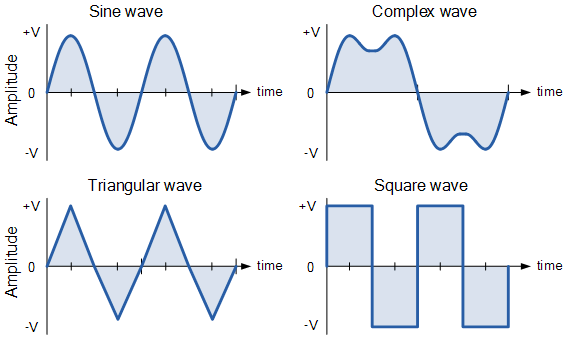You have 3 free guides left 😟
Unlock your guides6.3 Periodic Waves
4 min read•june 18, 2024
Saarah Hasan
Daniella Garcia-Loos
Saarah Hasan
Daniella Garcia-Loos
First off, what even is a ? Don’t panic, it’s not too complicated!
A periodic wave is a wave that has a repeating continuous pattern; it’s essentially a wave that repeats for several cycles. It can be characterized by its wavelength, period, , and . All the waves below can be considered periodic waves.

Taken from Wikimedia Commons
Here are some key points about periodic waves:
- A periodic wave is a wave that repeats at regular intervals, or periods.
- The period of a wave is the time it takes for one complete cycle of the wave to occur.
- The frequency of a wave is the number of cycles of the wave that occur per second. It is measured in Hertz (Hz).
- The wavelength of a wave is the distance between two consecutive points on the wave that are in phase.
- The speed of a wave is the distance traveled by the wave per unit time. It is equal to the product of the wavelength and the frequency of the wave.
- The amplitude of a wave is the maximum displacement of the wave from its resting position.
- The shape of a periodic wave is described by its waveform.
- Periodic waves can be classified as or , depending on the direction of the displacement of the wave relative to the direction of propagation.
The Wave Equation
In Physics 2, we mainly focus on simple periodic waves that can be described with equations involving a sine or cosine function, as well as the wavelength, amplitude, and frequency of the wave.
As a function of time, the equation would look like:
- f(t) = A cos(ω*t) ⏩ ω=2 π/T
- f(t) = A cos(2π/T*t) ⏩T=1/f
- f(t) = A cos(2πft) As a function of position, the equation would look like:
F(x)=A cos (2π/λ*x)
where:
- A = Amplitude
- T = Period
- f = Frequency
- λ = Wavelength
- t = Time
- x = Position
- ω =
Let's practice together a little.

Take a look at this graph, where the x-axis is the horizontal position and the y-axis is the vertical height of the wave.
What's the general equation for periodic waves that are graphed as a function of position?
-
F(x)=A cos (2π/λ*x) What's the amplitude for this wave? (What's highest/lowest point on the graph?)
-
4 What's the wavelength? (Measure the distance from crest to crest, or trough to trough)
-
(6-3) = 3 And that's it! The equation for this wave would look like:
-
f(x) = A cos (2π/λx) ➡️ f(x) = 4 cos(2π/3x) Here are some key points about the :
-
The wave equation is a mathematical equation that describes the behavior of waves. It is a that describes the relationship between the displacement of a wave and the time and space variables that define the wave.
-
The wave equation is used to describe a wide range of waves, including sound waves, light waves, and water waves.
-
The wave equation is a second-order differential equation, meaning that it involves second-order derivatives of the displacement with respect to time and space.
-
The general form of the wave equation is: ∂^2y/∂t^2 = c^2 ∂^2y/∂x^2
Where y is the displacement of the wave, t is time, x is space, and c is the speed of the wave.
- The wave equation can be solved using a variety of mathematical techniques, including separation of variables and Fourier series.
- The solutions to the wave equation are called wave functions, and they describe the shape and behavior of the wave.
Practice Problems 🧩
- The frequency of the tuning fork is (approximately)...
B) 0.020 s
C) 2.55 Hz
D) 50 Hz
E) 256 Hz

- What is the amplitude of the wave?
(A) 4 cm
(B) 5 cm
(C) 8 cm
(D) 10 cm
(E) 16 cm
- What is the speed of the wave?
(B) 25 cm/s
(C) 50 cm/s
(D) 100 cm/s
(E) 200 cm/s

- What is the length of the longest wavelength shown?
A) 0.5 m
B) 0.75 m
C) 1 m
D) 2 m
E) 4 m
- Which organ pipe(s) shows a standing wave which has twice the frequency of one of the other waves shown?
A) Cy
B) Cz
C) Ox
D) Oy
E) Cy , Cz, Ox, Oy
Answers
- E: f = cycles / seconds
- A: By inspection
- C: By inspection, the λ is 10 cm. f = 1 / T = 5, Then use v = f λ.
- E: Cx is only ¼ of a wavelength. To make a full wavelength you would need 4x the current length
- D: Wavelengths of each are (dist/cycle) … 4L, 4/3 L, 4/5 L, L, 2/3 L …Frequencies are f = v/ λ.v/4L, 3v/4L, 5v/4L, v/L, 3v/2L … Oy is 2x Cy
© 2024 Fiveable Inc. All rights reserved.
AP® and SAT® are trademarks registered by the College Board, which is not affiliated with, and does not endorse this website.
